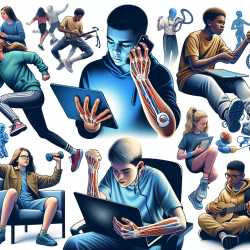Feeling burnt out, my dear mental health professionals? Trust me, we've all been there. Between juggling endless paperwork, managing classroom disruptions, and trying to fit in a lunch break that doesn't involve a granola bar, it’s no wonder you’re feeling like a well-worn pencil—sharpened to the nub.
But wait! Before you consider running off to a deserted island, let’s talk about something that might just put a spring back in your step: virtual therapy. Yes, you heard that right. You can now deliver your invaluable services without even leaving the comfort of your office chair. And no, you don’t need to wear pants. (Just kidding—please wear pants.)
Why Virtual Therapy?
First things first, let’s get one thing straight: virtual therapy is not some futuristic, sci-fi scenario where you need to wear VR goggles and speak in binary code. It’s a real, viable option that’s changing the game for schools and mental health professionals alike.
- Flexibility: With virtual therapy, you can schedule sessions that fit your timetable. No more running from one end of the school to the other, or worse, from one school to another.
- Accessibility: Students who might otherwise miss out on therapy due to logistical challenges can now access services from anywhere. All they need is an internet connection and a device. And hey, if they can find Wi-Fi in a treehouse, more power to them!
- Efficiency: Forget about commuting. Forget about setting up and packing away materials. Everything you need is right there on your screen. Plus, you can actually see the bottom of your desk for the first time in years.
But Does It Work?
Oh, you bet it does! Numerous studies have shown that virtual therapy is just as effective as in-person sessions. In fact, for some students, the screen acts as a buffer, making them feel more comfortable and less anxious. Think of it as the digital equivalent of a security blanket.
And let’s not forget about the benefits for you, the mental health professional. Online therapy jobs offer you the chance to diversify your skills and even your client base. Plus, you get to avoid the dreaded ‘school flu’ that seems to circulate every winter. Double win!
Speech Therapy in Schools: A Case Study
Take, for example, speech therapy in schools. Virtual sessions have been a game-changer. Not only can therapists reach more students, but they can also use interactive tools and games that make learning fun. Imagine playing a game of digital Pictionary to help a student with articulation issues. It’s like hitting two birds with one stone—except, you know, without harming any birds.
Tips for Making Virtual Therapy a Success
Alright, so you’re sold on the idea. But how do you make sure it works for you and your students? Here are some tips:
- Get Tech-Savvy: Familiarize yourself with the platform you’re using. Most are pretty user-friendly, but it never hurts to play around with the features before your first session.
- Set the Scene: Make sure you have a quiet, well-lit space where you won’t be interrupted. A good backdrop is also key. No one needs to see your laundry pile.
- Engage and Interact: Use the tools at your disposal to make sessions interactive. Share your screen, use digital whiteboards, and incorporate multimedia elements to keep students engaged.
- Be Patient: Technical glitches happen. It’s the nature of the beast. Have a backup plan and don’t stress if things go awry. Remember, laughter is the best medicine—even in therapy sessions.
Conclusion
So there you have it. Virtual therapy is not just a passing trend; it’s a revolution in how we deliver mental health services in schools. It offers flexibility, accessibility, and efficiency—all while keeping you sane and your students engaged. So, why not give it a try? Your well-worn pencil might just get a new lease on life.
And if you’re interested in exploring online therapy jobs, TinyEYE is always looking for talented professionals to join our team. Together, we can make a difference—one screen at a time.










